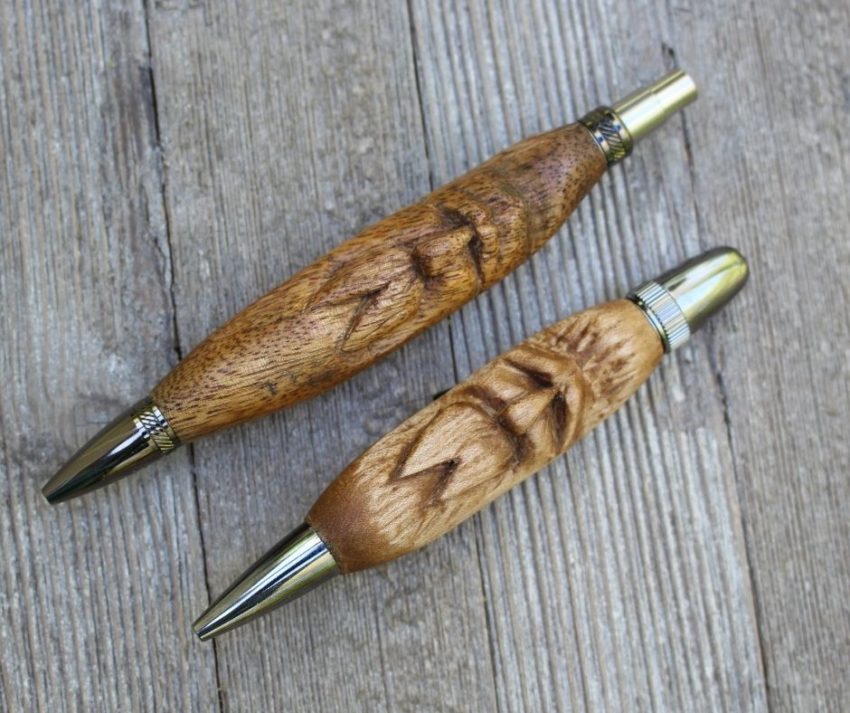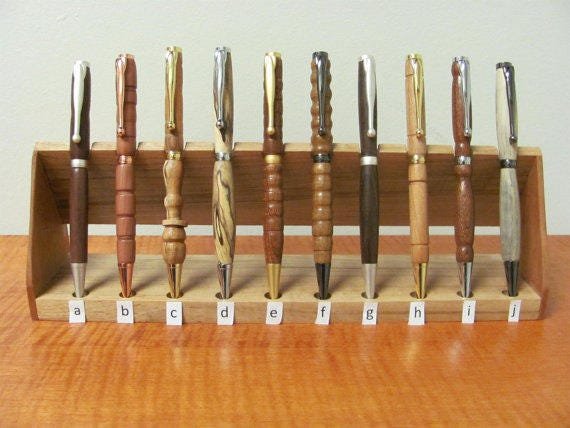Table of Contents
Pen turning designs involve crafting unique pen bodies from various materials using a lathe. These designs can range from simple to intricate patterns.
Pen turning is a popular craft that combines artistry and functionality. Crafters use a lathe to shape materials like wood, acrylic, or metal into unique pen bodies. The choice of material and design can greatly influence the pen’s aesthetics and feel.
Many pen turners experiment with different techniques, such as inlays, segmenting, and custom blanks. These techniques allow for endless creativity and personalization. Pen turning not only offers a rewarding hobby but also produces beautiful, one-of-a-kind writing instruments. This craft appeals to both beginners and experienced woodworkers, providing a satisfying blend of skill and creativity.
The Art Of Pen Turning
Pen turning is a unique art. It combines craftsmanship with creativity. Turners use wood to make beautiful pens. Each pen is unique and special. The process starts with choosing the right wood. Exotic woods are often preferred. They have beautiful patterns and colors.
The journey from wood to pen involves several steps. First, the wood is cut into small blanks. Each blank is then drilled and fitted with a brass tube. After that, the blank is mounted on a lathe. The lathe spins the wood very fast. The turner uses tools to shape the spinning wood. Sanding and polishing come next. These steps make the pen smooth and shiny. Finally, the pen is assembled with metal parts. The end result is a beautiful, handcrafted pen.

Credit: m.youtube.com
Essential Tools And Materials
Creating exquisite pen turning designs demands precision tools and quality materials. Essential items include a lathe, chisels, pen blanks, and finishing supplies.
Selecting The Right Lathe
A lathe is a key tool for pen turning. A good lathe must be stable and accurate. Small lathes work well for beginners. Larger lathes are better for advanced users. Look for variable speed control. Speed control helps in different tasks. Ensure the lathe is easy to use and maintain. A sturdy lathe base is also important. It keeps the lathe steady during work. Tailstock and headstock alignment should be perfect. This ensures smooth turning.
Types Of Wood And Acrylic Blanks
Wood blanks come in many varieties. Maple, cherry, and walnut are popular choices. Each type has unique grain patterns. Acrylic blanks offer bright colors and designs. Acrylic is harder to turn but polishes well. Stabilized wood combines the best of both. It is wood treated with resin. This makes it strong and colorful. Choose blanks that are free from cracks and imperfections. Quality blanks make better pens.
Design Principles For Elegant Pens
Balance is very important in pen design. A well-balanced pen feels good in the hand. Proportion also plays a big role. A pen with good proportion looks nice and works well. The length, width, and shape must all match each other. This makes the pen both beautiful and functional.
Color choice can make a big difference. Bright colors make a pen stand out. Dark colors give a classic look. Combining colors can create unique designs. Some people like simple colors. Others prefer bold, bright colors. It’s important to choose colors that match the overall design.
Techniques For Shaping And Turning
The skew chisel is an important tool. It helps create smooth and precise cuts. Hold the chisel at an angle. This way, you can shape the pen blank easily. Practice makes perfect with the skew chisel. Always keep the chisel sharp. A sharp tool works better and is safer to use.
Sanding makes the pen smooth. Start with a coarse grit. Use finer grits step by step. Each grit makes the pen smoother. After sanding, polish the pen. Use a soft cloth for polishing. This adds a shiny finish to the pen. Sanding and polishing are key steps. They give the pen a professional look.
Innovative Pen Turning Designs
Adding inlays can make pens unique and beautiful. Inlays can be made from wood, metal, or acrylic. These materials add a special touch to each pen. Engravings can add personal details. You can engrave names, dates, or designs. This makes pens great for gifts. Inlays and engravings both add value and beauty. They turn a simple pen into a work of art.
Themed pens can be based on hobbies or interests. Sports themes are popular. Movie or book themes are also fun. Novelty pens can be shaped like animals or vehicles. These pens are great for collectors. They make writing more fun and interesting. Custom pens can fit any theme you like. They make perfect gifts for special occasions.

Credit: www.fouroakscrafts.com
Finishing Touches For Durability And Shine
CA glue creates a very durable finish. It is also known for its high shine. Apply thin layers of CA glue to the pen. Wait for each layer to dry before adding the next. Use sandpaper to smooth the surface after each layer. Start with coarse sandpaper. Then move to finer sandpapers. This makes the pen very smooth. Finally, polish the pen with a soft cloth. This makes the pen shine brightly.
Wax can make the pen surface gleam. Use a soft cloth to apply the wax. Rub the wax onto the pen gently. Make sure to cover all areas. Let the wax dry for a few minutes. Buff the pen with a clean cloth. This makes the pen shiny and smooth. Wax also adds a protective layer. This helps keep the pen looking new.
Personalizing Pens For Special Occasions
Custom engravings make pens unique. A name or date can be added. This makes the pen special. Engraved pens are great gifts. They show thought and care. They are perfect for birthdays. They also work well for anniversaries. Even graduations are a good time for these pens.
Pens can have themed designs. Choose designs for Christmas. Pick patterns for Halloween. Easter pens can have eggs and bunnies. Holiday-themed pens are fun to give. Events like weddings can have special designs too. These pens make great keepsakes. They remind people of happy times.
Turning Your Hobby Into A Business
Show your pens at local craft fairs. People love seeing and touching the products. Share photos of your pens on social media. Use platforms like Instagram and Facebook. Make sure to use good lighting and clear shots. Write engaging captions to grab attention. Connect with other crafters online. Join groups and forums related to pen turning.
Choose a platform like Etsy or Shopify. They are easy to use. Take clear, bright photos of your pens. Write detailed descriptions. Include the type of wood and any special features. Set fair prices based on your materials and time. Offer multiple payment options to customers. Make sure to package your pens well for shipping. Happy customers often leave good reviews. This helps attract more buyers.
Community And Resources
Pen turning forums are fun places. People share tips and tricks there. You can learn a lot from others. It’s easy to ask questions. You will feel part of a community. Your skills will improve quickly. Many forums are free to join. There are forums for all skill levels. Beginners and experts help each other. It’s a great way to make new friends. You can also show off your work. Others will give you feedback. This helps you get better.
Workshops are great for hands-on learning. You can see experts at work. This helps you understand better. Workshops often have small groups. This means more personal attention. You can ask lots of questions. There are workshops for all levels. Find one near you. Many workshops offer materials. This saves you time and money. Continued learning keeps your skills sharp. Always look for new workshops. Never stop learning.

Credit: www.pinterest.com
Frequently Asked Questions
What Are The Different Types Of Pens For Turning?
There are several types of pens for turning, including ballpoint, rollerball, fountain, and gel pens. Each offers unique writing experiences and styles.
What Rpm For Pen Turning?
The ideal RPM for pen turning is 3,000 to 3,500. Adjust speed based on material and tool type.
What Does A Pen Turner Do?
A pen turner crafts custom pens using a lathe. They shape materials like wood, acrylic, or metal into unique designs.
How To Make A Pen With Wood?
To make a wooden pen, gather a wood blank, pen kit, and lathe. Turn the wood to desired shape. Sand and finish it. Assemble the pen components. Enjoy your handcrafted pen!
Conclusion
Explore various pen turning designs to unleash your creativity and craft unique pens. Experiment with different materials and patterns. Each pen you create can be a masterpiece, reflecting your personal style. Keep honing your skills, and soon, you’ll be turning heads with your stunning pen designs.
Happy crafting!
